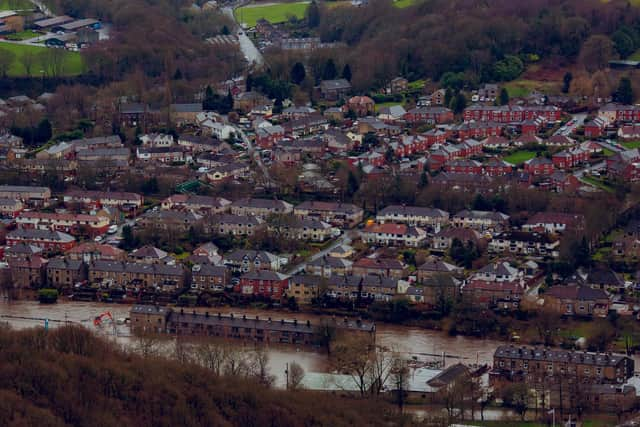Cost of Yorkshire's Storm Ciara more than £65m for local businesses in Calderdale, says new study
Storm Ciara caused Calderdale’s second worst flood to hit the Calder Valley in recent years after the Boxing Day floods of 2015.
The aftermath left some 1,500 homes and businesses flooded in the West Yorkshire borough and caused severe disruption around the country.
Advertisement
Hide AdAdvertisement
Hide AdNow a new study, led by the University of Leeds, has revealed that in the winter of 2019/2020, floods in Calderdale cost local companies about £43m in direct losses, plus £25m in indirect losses.


Researchers say a new framework is needed for insurers to work more closely with businesses across the region that have struggled in the past to secure flood insurance.
Dr Paola Sakai, the lead author and a climate change economist at the University of Leeds, said: “Small and medium-sized enterprises (SMEs) are the lifeblood of local economies. At present, SMEs that have previously been flooded or are based in a floodplain find it very difficult to secure flood insurance.”
Dr Sakai added: “With temperatures rising globally, we are expected to experience an increase in extreme weather events – with flooding the UK’s main climate-related threat.


Advertisement
Hide AdAdvertisement
Hide Ad"As a result, both SMEs and the insurance industry will suffer, as more businesses become ineligible for flood insurance."
Apart from the direct cost of flood damage to property and stock, said Dr Sakai, there were significant additional costs, particularly if companies are part of supply chains and had to temporarily close for a significant period following a flood.
“It is increasingly important that local and regional authorities have a better understanding of both the direct and indirect costs of the impact of flooding on SMEs and that the insurance industry offers more adequate insurance products,” she added.
Flooding in recent years has caused devastating consequences to the business sector in the the region and nationwide.


Advertisement
Hide AdAdvertisement
Hide AdThe direct cost of clear-up after Calderdale's two biggest floods in 2015 and 2020 was around £2m, though the Government reimbursed the council for £1.4m. This does not include the cost of repairs to buildings and infrastructure such as roads and bridges which were necessary afterwards.
And in Calderdale during last year's winter floods for each £1 of direct losses such as loss in trade due to business interruption, there are £0.63 additional losses across the local and regional economy.
Dr Marco Sakai, the study’s co-author, and a Lecturer in Ecological Economics at the University of York, said: “SMEs are an essential part of any region’s economy and represent an essential fabric of communities.
“In fact, they are responsible for 99 percent of the business base in Yorkshire, providing vital employment, goods and services.
Advertisement
Hide AdAdvertisement
Hide Ad“Not taking effective action to mitigate flooding decreases the resilience of not only SMEs, but also of entire towns.
“By preparing for future floods, SMEs can limit the disruption caused by water damage and work with insurance companies to protect and even expand their business.”
As part of the new study, 135 SMEs were surveyed, of which 126 are located in 15 districts across the Yorkshire and the Humber region, and 6 SMEs were analysed in more depth.
The report is a collaboration with the West Yorkshire Combined Authority, Leeds City Region Enterprise Partnership (LEP), Leeds City Region local authorities, and the Environment Agency.
Advertisement
Hide AdAdvertisement
Hide AdIt follows a Leeds City Region Flood Review published in 2016.
Roger Marsh, Chair of the LEP and NP11 Group of Northern Local Enterprise Partnerships, said: “This project will help improve the economic assessment tools that we currently use to determine the true costs of flooding to SMEs and its wider economic impact on our communities.
“The tool developed by the University of Leeds will also enable us to better articulate the need for future investment in flood risk management infrastructure and our response to future flood events across the City Region.”
Results from the study also showed medium sized companies reported direct economic losses of 24 per cent of their monthly turnover on average, while for smaller firms losses were 113 per cent.
Advertisement
Hide AdAdvertisement
Hide AdWhile areas hit hardest were equipment, business interruption and exterior repairs. It took an average of four months for businesses to return to pre-flood level of sales.
The 2019/2020 winter floods caused premises to close for an average of 13 days, with the loss of 57 jobs and a 31 per cent drop in sales for the first month after flooding.
Coun Tim Swift, West Yorkshire Combined Authority’s Portfolio holder for Climate and the Environment, added: “This study is helping us better understand the needs of SMEs and improve our flood risk management strategy.
"This collaborative initiative is an important step towards our ambition to make West Yorkshire a place where everyone can enjoy the economic, health and environmental benefits of a net-zero carbon economy by 2038."
__________
Support The Yorkshire Post and become a subscriber today.
Advertisement
Hide AdAdvertisement
Hide AdYour subscription will help us to continue to bring quality news to the people of Yorkshire. In return, you'll see fewer ads on site, get free access to our app and receive exclusive members-only offers. Click here to subscribe.
Comment Guidelines
National World encourages reader discussion on our stories. User feedback, insights and back-and-forth exchanges add a rich layer of context to reporting. Please review our Community Guidelines before commenting.
